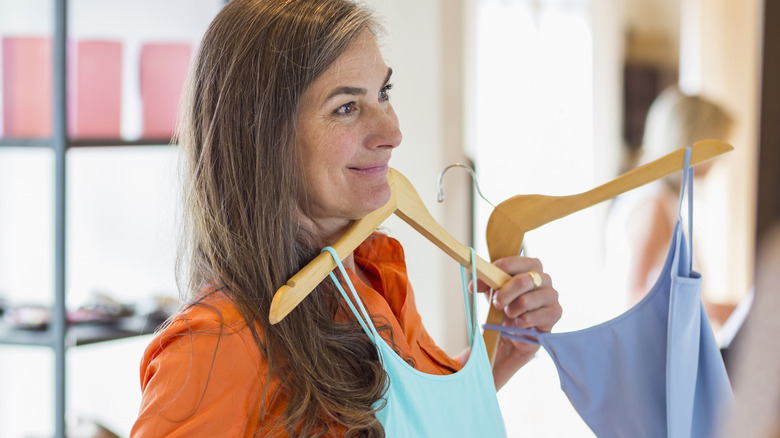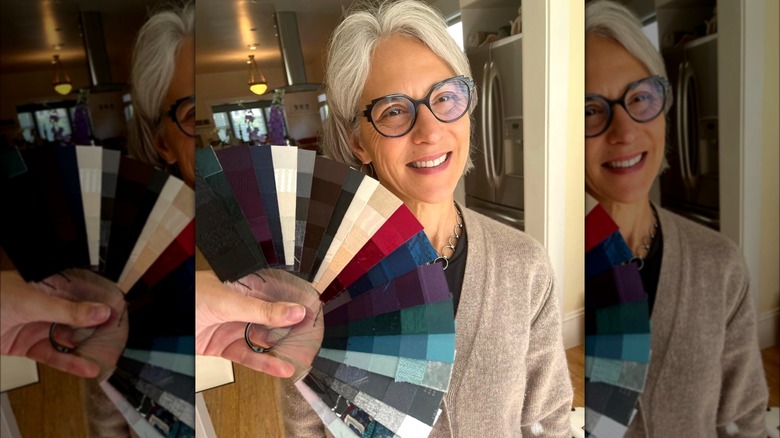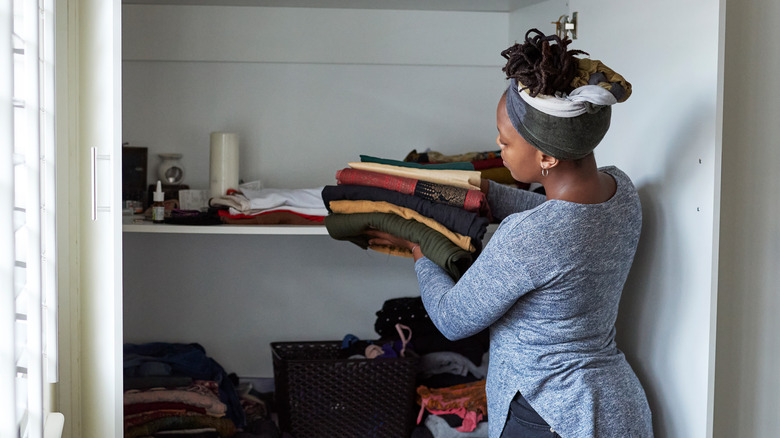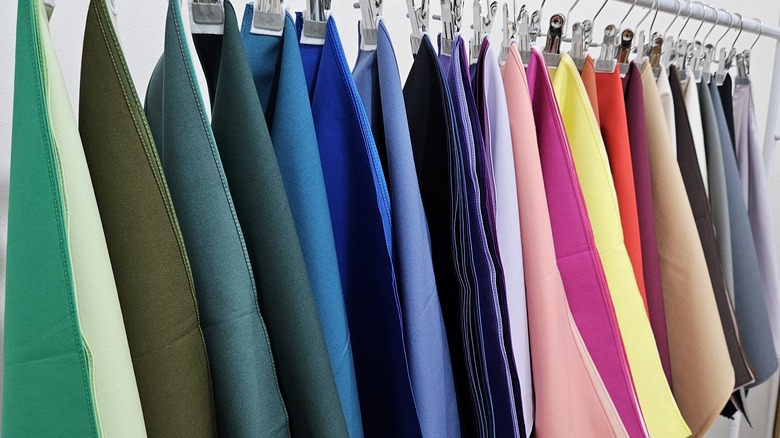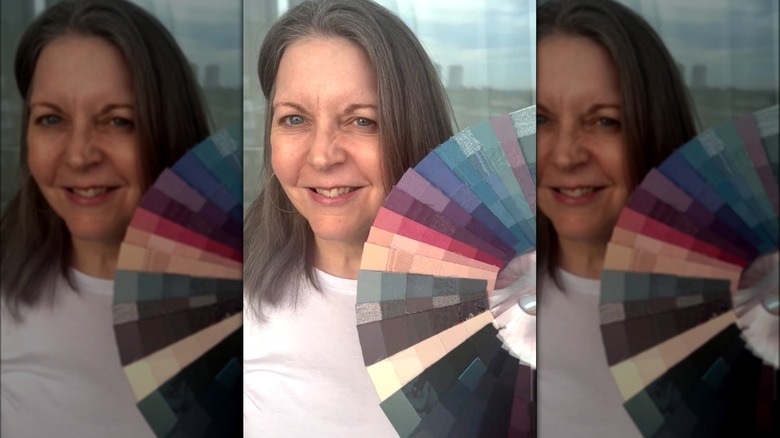Why Everyone Over 50 Should Have Their Color Analysis Done
Someone call the 1980s — color analysis, one of the biggest fashion and beauty trends of the decade, has come back with a vengeance. Once considered passé, color analysis has taken TikTok by storm, with color-matching filters and the hashtag #coloranalysis racking up more than 280,000 posts. This trend builds upon the idea of color "seasons," categorizing individuals into color groupings based on spring, summer, autumn, and winter. But color analysis is more complex than it seems, and this boom isn't just for Gen Z or content creators. On the contrary, modern color analysis is an absolute game-changer for the 50+ crowd.
@jamiegenevieve Help #coloranalysis
To find out what the art of color matching has to offer, Glam spoke exclusively to certified color analyst Justine Glaser. As the founder of Colors by Midnight, Glaser offers comprehensive color analysis services in-person in Los Angeles and virtually over Zoom for people of every age group. "I have a lot of clients who are over 50 that come to see me. It's never too late to get a color analysis," Glaser tells us.
In fact, the analyst strongly recommends color matching for mature clients, adding, "When we look in harmony, others notice. I once had a 60-year-old client tell me that they no longer felt invisible after receiving a color analysis." But what makes color analysis so valuable for those aged 50 and up? As Glaser explains, professional color matching can be transformative for both first-timers and those in need of a refresh.
Color analysis highlights your timeless beauty at any age
If you've gone a few decades or more without getting your colors evaluated, you probably don't know what you're missing — or how much certain shades can impact your overall look. Color analysis is all about complementing your inherent features and complexion by narrowing down the ideal hues you should be prioritizing. As Justine Glaser exclusively explains to Glam, "When I build color palettes, I look at the skin, natural hair color, and eye color and build a range of colors." This process involves draping clients in curated rainbows of fabric to see how shades interact with their coloring. "When I drape, I make sure the person wears white to neutralize them, I cover their hair if they color it, and I test fabrics against their skin and observe the responses to the different colors," Glaser adds.
The resulting spectrum of recommended colors is expertly hand-picked to bring out your natural beauty, helping you choose shades to wear and surround yourself with. This is a boon for everyone, but especially for older clients. "I describe wearing the correct colors as having a natural Instagram filter," says Glaser. "A color analysis is one of the best ways to fight against aging. The correct colors will accentuate the face and create a natural glow." In other words, curating your color palette is a hack to downplay signs of aging like age spots, wan skin, and visible veins, all while emphasizing your best features. Who doesn't love an easy, non-invasive glow-up?
Color analysis can help streamline and harmonize your lifestyle
Sometimes, it feels like the older we get, the more we appreciate a lifestyle that's smooth, mindful, and harmonious — and color analysis fits right in with these goals. Justine Glaser exclusively explains to Glam the surprising practical and financial benefits of the practice: "A color analysis helps save money because you don't waste money on buying items that don't work, you save money at the hair salon by not needing a color correction, and nothing goes to waste by just sitting in your closet." Basically, color analysis helps you dodge unnecessary stress and expenses by making better choices upfront, down to choosing your next hair color based on your season.
When downsizing an overstuffed wardrobe, knowing your color palette is also a tool to help declutter and organize your closet. But this doesn't necessarily mean you have to rebuild your entire aesthetic from the ground up. "I have had clients who really take a plunge and revamp their whole wardrobe right away. I also have had clients who are more conservative," Glaser tells us. "I would say start small. Start with a lipstick in one of your colors, or buy one new shirt and see how it feels."
Toward building a more seamless, cohesive look and lifestyle, Glaser also points out applications for color theory that go beyond the walls of your closet. "A color analysis ... also produces the correct colors for hair colors, makeup, jewelry metals, accessories, and interiors for the home."
Color analysis has come a long way since it first started
Were you one of those early adopters who jumped on color analysis back in its previous heyday? Then you're probably styling yourself on a pretty decent foundation already. That said, Justine Glaser strongly encourages clients to consider updating their color analysis. For one thing, Glaser explains that color analysis has come a long way since its inception, and even clients who have already had their analysis done may benefit from the more advanced system in use today.
"In the '80s and '90s, the color analysis system was not evolved. There were only four seasonal categories with a very broad range of colors," Glaser exclusively explains to Glam. Due to the limitations of this original method, the analyst warns that many people may have received rudimentary palettes that only somewhat match their actual coloring. Worse yet, some people may have gotten totally inaccurate results. "I also have had clients previously get typed as an incorrect season because the techniques weren't as evolved as they are today," Glaser reveals. In contrast, Glaser's approach is based on the modern 16-season color analysis and Suzanne Caygill's 24-season method, offering much more specific and personalized palettes than the early days of color matching.
The nuances of your color analysis can change as you get older
There are various benefits to getting your colors done (or redone), but for clients in higher age brackets, Justine Glaser offers a particularly compelling reason: Your perfect color matches can shift over time. "When we age, our colors can soften because our features and hair become softer. There's a window called peak pigmentation that starts around 18 to 20 years old, post-puberty, and ends around 45 to 50 years old when we really start going gray," Glaser exclusively tells Glam. As we age, this can mean a move toward cooler, more muted skin tones — and, thus, a cooler overall color palette.
That said, it may not be a dramatic shift, as you're still the same person. "The seasonal result does not change," Glaser explains. "When someone receives the result of 'spring,' for example, they will be a spring for the rest of their life." But in today's nuanced system of color analysis, there's room to perfect that changing color alignment. For instance, someone who was once an earthy "warm spring" might pivot into the neutral pastels of "light spring" after 50.
This is where the guidance of a professional color analyst makes all the difference. While TikTokers go into tizzies over difficult-to-parse color-matching filters, Glaser recommends going straight to the experts. "Trust the process," Glaser says, and more than anything, "make sure to pick a color analysis professional that you feel confident in."
